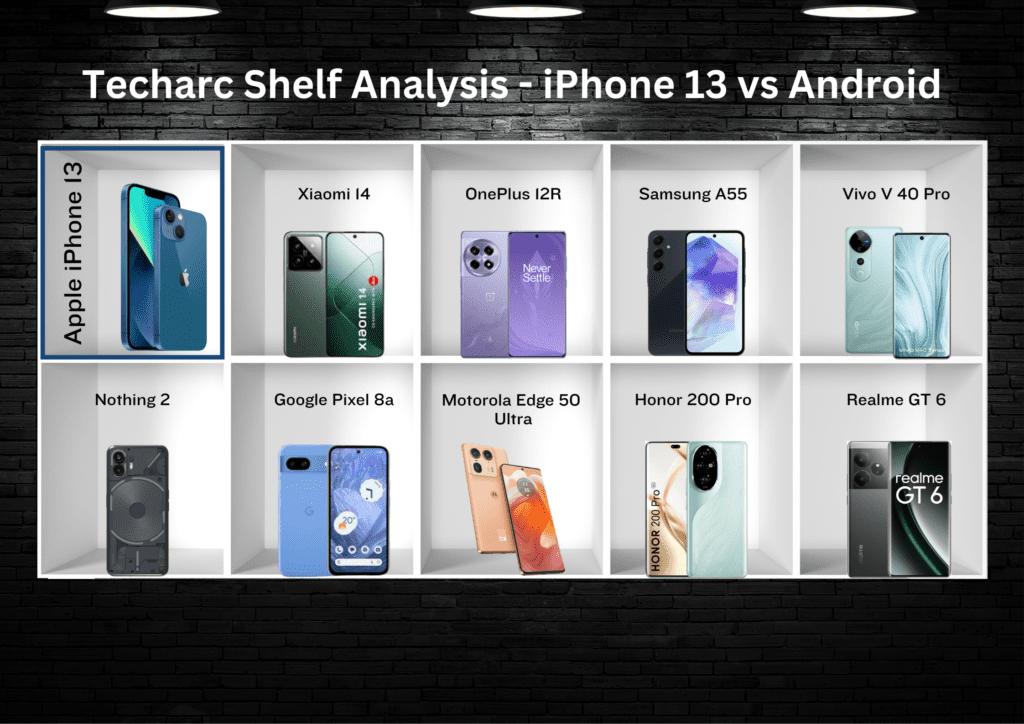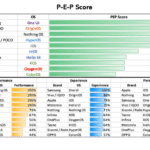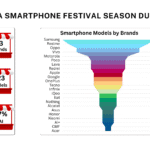Techarc Shelf Analysis of iPhone 13 with alternative android smartphones in the price range shows how consumers are ‘malnourished’ in terms of the latest generation of several key technologies.
No doubt iPhone is a craze in India! People just want to own this brand without real evaluation of the technologies they acquire or the products. There is a decade old perception that iPhone is smooth than its android counterparts. There are also some who buy the seamless experience proposition of Apple products. Many others are fans of Apple’s privacy. It’s not that all of these are wrong, or Apple doesn’t offer these value propositions. But at the same time, we cannot say that similar features and experiences are missing from the android ecosystem. One can understand that customers in India do appreciate the tech driven value that iPhone offers when they buy the latest models, but when they buy in great volumes older models, it cannot be anything other than owning the ‘iPhone’ tag for show-off. Our ‘shelf analysis’ of one of the very still popular iPhone models in India – iPhone 13 compares what is being offered to customers viz-a-viz other options that a consumer could buy for almost same price within android smartphones.

In this analysis we compared iPhone 13 with 9 smartphone models of different brands that are retailing around the same price. The models included in this shelf analysis were Xiaomi 14, OnePlus 12R, Samsung A55, Vivo V40 Pro, Nothing 2a, Google Pixel 8a, Motorola Edge 50 Ultra, Honor 200 Pro and Realme GT 6. We did not get into the processor debate as it becomes very subjective beyond a point to evaluate processors. Yes, there are third-party benchmarks like AnTuTu score which is by far the most widely used processor benchmarking tools available. But, even then, Apple could argue its Silicon is far more efficient than say Qualcomm or MediaTek processor on certain parameters affecting the overall performance of the smartphone.
The purpose of this shelf analysis was to investigate whether consumers are logically deciding when they buy an older iPhone such as iPhone 13? Irrespective of the segment we represent as consumers as defined by our socio-economic profile, we always invest in technology for future. We never buy any technology product for retrospective use. As a user, if I am buying any technology product in 2024, my expectation would be that this investment should be relevant for next 3 years or more depending on what I am buying. But the consumer behaviour of purchasing an older iPhone like iPhone 13 is a paradox to this logical and rational buying. Let’s see what the shelf analysis comparison reveals.
RAM – We all understand the significance of RAM in any compute device including smartphones. It affects real-time performance and experience that a consumer interfaces with. It also shapes how our concurrent usage of various applications of a smartphone would define. Consumers when choosing iPhone 13 over other options available are investing in an older generation of RAM which is obviously not as efficient and capable as the succeeding generation. The iPhone 13 comes with LPDDR4X RAM type while all others listed in the shelf analysis are equipped with LPDDR5X type of RAM. At the time of purchase, it may not make much of a difference. But when we factor that we are purchasing this device for future use and the hardware in it should be efficient and capable to serve future digital habits also, we are under-equipping ourselves.
Storage – Yes, storage is one such area, where I would rate iPhone 13 better than those listed out in the shelf analysis. Reason being, it uses NVMe type of storage while others use UFS of different generations. Even if some of the android smartphones compared have UFS 4.0 storage type, NVMe is any day better in performance. As regards storage, we can say that iPhone 13 is relatively a better choice.
Refresh rate – We consume all sorts of content ranging from slow moving content like text to games requiring very high refresh rates to show up immersive experiences. Here too, by opting for iPhone 13, we are getting a maximum of 60 Hz refresh rate, while all other android options except Motorola Edge 50 Ultra offer double, 120 Hz of refresh rate. The Motorola Edge 50 Ultra offers 144 Hz of refresh rate. This means significant difference in consuming content which is more dynamic like playing games and watching videos as the android phones here are capable of faster frame refresh delivering a smooth experience.
Brightness – Smartphone is an anytime, anywhere device. We need it equally outdoors as much as we depend on it indoors. The peak brightness a smartphone can support as measured by NITs is an important attribute defining the range of brightness of light in which the smartphone screen can work and display the content easily visible to us irrespective of whatever brightness levels we are exposed to. For instance, a peak summer day, noon time with a very bright sun light. Here also, iPhone 13 offers a maximum of 800 nits of peak brightness while other phones offer 1000 nits and above going right up to 6000 nits in case of Realme GT 6. OnePlus 12R and Vivo V40 Pro offers next best at 4500 nits followed by Xiaomi 14 at 3000 nits.
Ingress protection – Due to omni-use characteristics of a smartphone, as consumers we are all concerned about the protection it has against any dust particle or moisture getting into it. For this we have IP ratings which indicate the extent to which the device can resist such environments and keep the device protected. Fortunately, on this measure, iPhone 13 offers IP68 rating which is more than that offered by others. Within android smartphones, its only Xiaomi 14 and Vivo V40 Pro which also offers the same protection rating.
Battery and charging – Obviously when our daily active usage of the device as well as ‘on-net’ duration is consistently going upwards, the device has to support this consumer digital behaviour by offering matching battery capacity as well as the ability to quickly reload power. iPhone 13 has the lowest battery capacity of 3240 mAh, while most of the android smartphones compared offer 5000 mAh in the range. OnePlus 12R, Vivo V40 Pro and Realme GT 6 go even further to 5500 mAh of battery capacity. Not only that the android smartphones also support much faster charging speeds. iPhone 13 again supports only 20w charging speed, which is not by the way the lowest. Here Google Pixel 8a does even lower than this at 18w which is even worse than this considering its battery capacity is 4492 mAh. These phones are premium phones. Customers do expect these phones to support premium features like wireless charging as well. iPhone 13 supports 15w wireless charging, while as phones like Xiaomi 14 and Honor 200 Pro support 50w and 66w of wireless charging. So, here again, iPhone 13 has less to offer. But the good point is that it at least supports wireless charging unlike OnePlus 12R and Vivo V40 Pro which are in the same range. Some brands are also supporting reverse wireless charging which can be very handy in situations when one is running out of battery and doesn’t have a charging port nearby or does not carry a power bank. Xiaomi 14, Nothing Phone 2 and Honor 200 Pro support 5w of reverse wireless charging. In nutshell, in power capacity and capabilities there are android smartphones that outshine iPhone 13 in the range.
Wi-Fi – Do we realise that most of us are connected to Internet through Wi-Fi for majority of the day? Be it home or office, we could be primarily connected to the Wi-Fi even if the smartphone has an active cellular connectivity. Wi-Fi is very important aspect of a smartphone affecting its holistic experience and efficiency, which we many times simply ignore. The iPhone 13 offer Wi-Fi 6, while there are already phones in this range like Xiaomi 14, Motorola Edge 50 Ultra and OnePlus 12R that have Wi-Fi 7 to offer. One might argue that even if the devices have Wi-Fi 7, its of no use at the moment. While that’s correct, the hardware capability makes a customer future ready. Nothing Phone 2 and Google Pixel 8a has Wi-Fi 6E support, which again is better than Wi-Fi 6. For Wi-Fi which is one of the very critical attributes of a smartphone, iPhone 13 again does not make a consumer future proof.
Bluetooth – With the increasing need of creating PAN or personal area network where we connect wearables with the smartphones, Bluetooth has become all important. Be it connecting to TWS, smart watch, rings or even the audio systems of a car, Bluetooth is all important. Upon comparing, iPhone 13 offers Bluetooth 5.0, while most of the android smartphones in the range included in our shelf analysis offer 5.2 or higher version of this wireless technology.
There can be some other elements also that one can find from the shelf analysis and satisfactorily conclude that consumers investing in older iPhone generations like iPhone 13 are giving up a lot of newer technologies that are going to impair their experience in near future. Even if we go on comparing the exteriors and design elements, the android smartphones available have much more to offer like curved display, sleek body and in some cases definitely better designs. Undoubtedly consumers are ‘malnourishing’ themselves by acquiring obsolete or soon to be obsolete generations of key technologies that add up to the holistic experience and performance of a smartphone.





